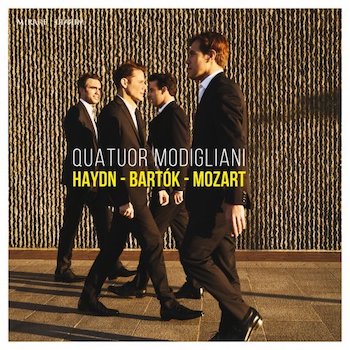Classical Album Review: Quatour Modigliani plays Haydn, Bartók, and Mozart
By Jonathan Blumhofer
Any number of threads tie these three pieces (and composers) together. But in this instance, such busywork is superfluous: the musical results — blazingly played and flawlessly recorded — speak for themselves.
 Quatour Modigliani’s new survey of string quartets by Franz Josef Haydn, Béla Bartók, and Wolfgang Amadeus Mozart is, on the one hand, an exercise in playing of unfailing elegance and warmth. Surely, one would be hard-pressed to ask for a more graceful take on the second movement of Haydn’s D-minor Quinten Quartet (or a more songful account of the same movement in Mozart’s C-major Dissonance Quartet, for that matter) than what they provide here.
Quatour Modigliani’s new survey of string quartets by Franz Josef Haydn, Béla Bartók, and Wolfgang Amadeus Mozart is, on the one hand, an exercise in playing of unfailing elegance and warmth. Surely, one would be hard-pressed to ask for a more graceful take on the second movement of Haydn’s D-minor Quinten Quartet (or a more songful account of the same movement in Mozart’s C-major Dissonance Quartet, for that matter) than what they provide here.
But there’s more to this music than mere surface beauty, and these performances capture much of it.
The outer movements of the Haydn (op. 72, no. 1) are spirited and rhythmically tight, the music’s bold contrasts of dynamics and tone strongly delineated. There’s an infectious rusticity in the Modigliani’s playing of the Minuet’s Trio, while the finale is highly characterful.
Their account of the Mozart (K. 465) overflows with Haydnesque brio. The first movement’s pungent introduction is plenty intense and harmonically urgent; that mood carries into the movement’s main body, which is fleet of tempo but elastically phrased.
In the minuet, the group’s playing is genial and fetchingly off-kilter, while the finale is executed with sprightly energy and given an impeccable sense of shape.
How does Bartók’s gritty String Quartet no. 3 fit in with these neighbors? Surprisingly well, it turns out.
Certainly, the opening of its “Prima parte” has rarely sounded as velvety as it does here; the cello glissandos played with a mix of textural clarity and tonal sumptuousness that’s fully absorbing. The Modigliani’s interpretation also thrives on good balances, never shying away from the density (or knottiness) of Bartók’s writing, but ably balances lucidity with momentum.
Similar characteristics define their approach to the “Seconda parte,” with its slashing tattoos and lyrical melodies. Here, the mechanical fugue is etched in bright hues and the part’s glissando apex is thrilling. So, too, the “Recapitulazione’s” final peroration, which comes over as a lusty, savage dance.
Ultimately, the qualities of the Modigliani’s Bartók reading — the terrific blend of angular, granitic playing and sumptuous lyricism; the diaphanous ensemble; the strength of tone; the “right” feel of the interpretation — connect naturally (if less dissonantly) to their Haydn and Mozart offerings.
To be sure, one can find any number of threads that tie these three pieces (and composers) together. But in this instance, such busywork is superfluous: the musical results – blazingly played and flawlessly recorded — speak for themselves.
Jonathan Blumhofer is a composer and violist who has been active in the greater Boston area since 2004. His music has received numerous awards and been performed by various ensembles, including the American Composers Orchestra, Kiev Philharmonic, Camerata Chicago, Xanthos Ensemble, and Juventas New Music Group. Since receiving his doctorate from Boston University in 2010, Jon has taught at Clark University, Worcester Polytechnic Institute, and online for the University of Phoenix, in addition to writing music criticism for the Worcester Telegram & Gazette.
